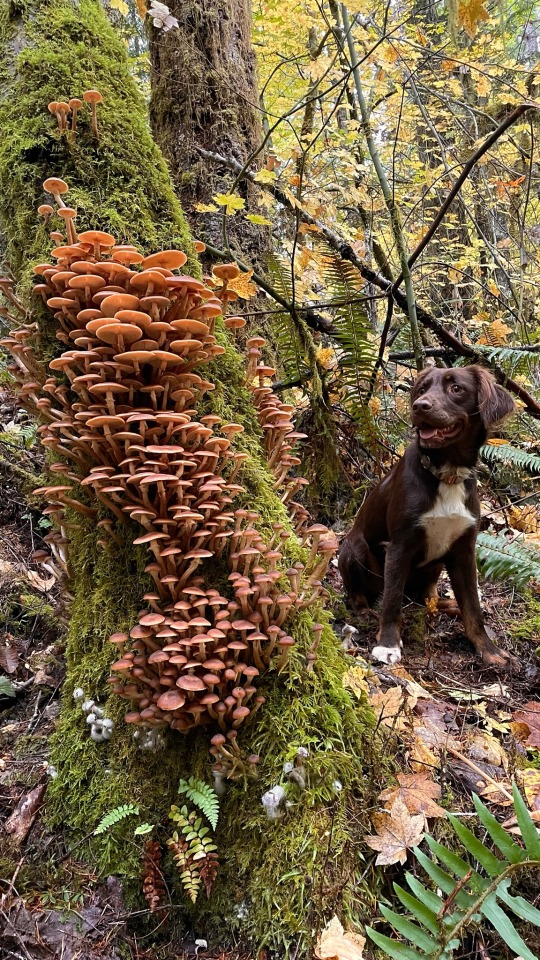Latest Posts by harvestpuppy - Page 2





Let’s get RATICAL 🐀🛹 Prints + stickers available on my patreon this month! ✨




Neil Banging Out the Tunes (2023)
Air-dry clay over foil and wire armature, EVA foam, acrylic paint, paint marker
i think this is probably one of the best rat videos i've ever seen and you all need to see it. just look at that calm beast









Spring fungi

Evening in the rainforest

Stormy hills

Commission for xaxallith 🐟


The most amazing fruiting of honey mushrooms I’ve seen to date. Dog for scale

ITS TIME 🎃🧡


From my theatre experience. Every time an animatronic would move/disappear the entire audience would GASP AND SCREAM IN SHOCK

I need to start using tumblr more often

The beautiful ones hurt you every time.
THIS IS WORSE THAN IF THEY SHOWED ME ED CRYING



HE STOLE THE CAKE TOPPERS AND MADE!!!! THE BRIDE!!!!! HIMSELF!!!!

𝐓𝐡𝐞 𝐛𝐥𝐨𝐨𝐝 𝐢𝐧 𝐲𝐨𝐮𝐫 𝐡𝐚𝐧𝐝𝐬

I Like chicken paninis


Redraw of a Coven drawing I used to be obsessed with in 2019 for some reason

Me & the pride fish gang💅




I drew these burst card frames of 2099 for the new Spiderverse trailer - (they’re only on screen for a fraction of a second!)
I really like this artstyle😭


trout trio

Drew some of the fish requests I got…



Happy Pride Month!
Faust the Crow loves you even more than she did the last 2 years!

Moonphase & Hollyskip, from my warriors AU


Brown Rat (Rattus norvegicus)
Family: Typical Mouse Family (Muridae)
IUCN Conservation Status: Least Concern
Fossil evidence and historical records suggest that the Brown Rat plausibly originates from somewhere in northern China and southern Mongolia, but after centuries of stowing away on ships and exploiting the resources available in human-altered habitats it is now among the most abundant and widely distributed mammals on earth, being found in large numbers almost anywhere where permanent human settlements exist. Relatively large for a member of its family, it owes its success to its extraordinary adaptability; intelligent and opportunistic, members of this species are able to endure a huge range of different climates by constructing elaborate burrows in which they can regulate the temperature, and (owing to their strong, continually growing teeth and unspecialised digestive system) can feed on almost any form of organic matter - while coarse plant matter, carrion, bird’s eggs and small vertebrates are preferred, the diets of different populations vary enormously depending on what resources are available. Brown Rats are also remarkably fast learners, and seem to teach one another - it has been observed that once a single Brown Rat living in an area has learned a specific skill needed to exploit a specific resource (such as learning to dive for fish,) others within its social group will quickly develop the same skill. Brown Rats live in loosely-structured social groups with a linear dominance hierarchy in which body size determines rank (with larger rats ranking higher,) but when resources are scarce these groups will become smaller or break apart entirely. Like most rodents, Brown Rats breed frequently and mature rapidly - after mating (usually during periods of warm weather, and often with numerous different males in a single breeding period,) females produce litters of up to 14 pups and gather in all-female social groups, with all of the mothers in a group sharing a communal burrow and cooperating to feed and protect their young until they become independent at around 4 weeks old. Although they can benefit ecosystems (serving as seed distributers, sustaining populations of rodent-eating predators and providing soil-dwelling organisms with oxygen by breaking up compacted soil when burrowing), invasive populations of Brown Rats have had devastating effects on many species, destroying the nests of birds, competing with indigenous mammals and transferring diseases between species. While humans generally regard members of this species as pests, a domesticated subspecies of Brown Rat (the Domestic Rat, Rattus norvegicus domesticus) is widely kept in captivity, both for use in research (where they are known as Lab Rats) and as pets (where they are called Fancy Rats.)
————————————————————————–
Image Source: https://www.inaturalist.org/taxa/44576-Rattus-norvegicus














